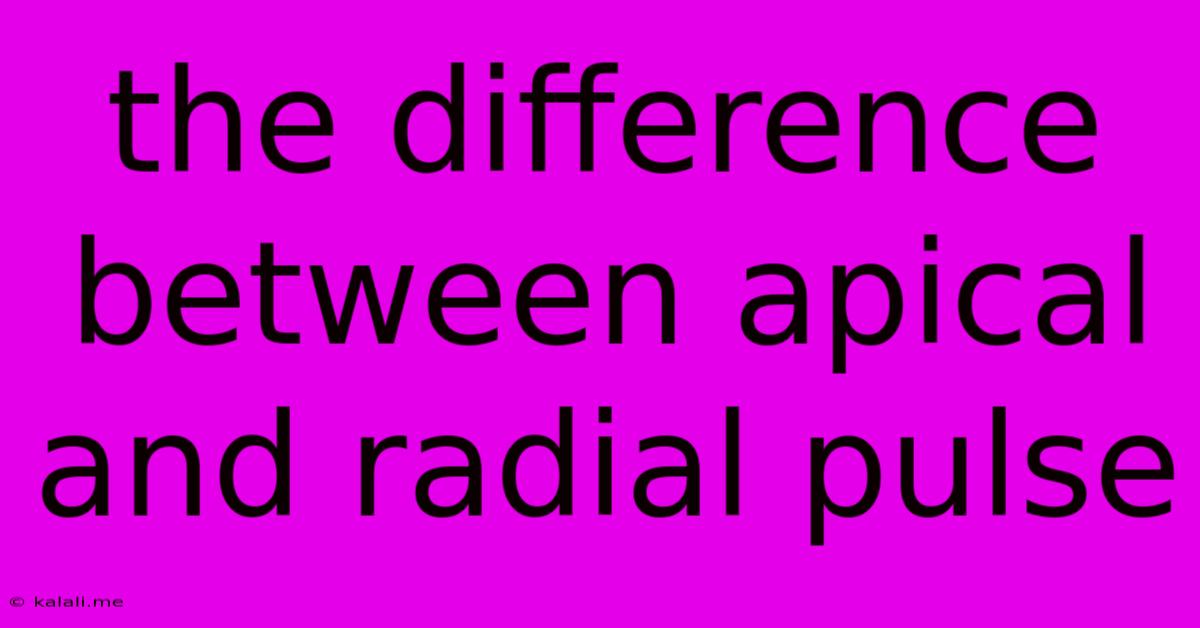The Difference Between Apical And Radial Pulse
Kalali
Jun 15, 2025 · 3 min read

Table of Contents
Apical vs. Radial Pulse: Understanding the Differences
Knowing how to take a pulse is a fundamental skill in healthcare, but understanding the nuances between different pulse measurement points can significantly enhance diagnostic capabilities. This article explores the key differences between apical and radial pulses, highlighting their individual uses and the significance of any discrepancies between them. This information is for educational purposes only and should not be substituted for professional medical advice.
What is a Pulse?
Before delving into the specifics, let's briefly define a pulse. A pulse is the rhythmic throbbing of arteries, caused by the expansion and contraction of the arteries as blood is propelled through them by the heart's beat. Measuring a pulse provides essential information about the heart rate, rhythm, and strength of the heartbeat.
Apical Pulse: The Heart's Source
The apical pulse represents the most direct measurement of the heart's activity. It's obtained by listening to the heartbeat using a stethoscope, placed over the apex of the heart – typically the fifth intercostal space, midclavicular line. This method provides the most accurate assessment of the heart rate, particularly in situations where the radial pulse might be difficult to palpate. The apical pulse directly reflects the actual heart rate.
- Advantages: Most accurate heart rate measurement, useful for irregular heartbeats (arrhythmias), and essential for infants and young children where a radial pulse may be difficult to detect.
- Disadvantages: Requires a stethoscope, takes more time than palpating a radial pulse, and requires some skill and practice.
Radial Pulse: A Peripheral Measurement
The radial pulse is a more commonly used peripheral pulse. It's easily palpable at the radial artery, located on the inner aspect of the wrist, just below the thumb. It’s frequently used for quick assessments of heart rate and rhythm. However, it's important to remember that the radial pulse is an indirect reflection of the heart's activity.
- Advantages: Easy to access and palpate, requiring minimal equipment, quick and convenient for routine monitoring.
- Disadvantages: Can be weak or difficult to palpate in certain conditions (e.g., low blood pressure, dehydration), may not accurately reflect the heart rate if there's a significant difference between the apical and radial pulses (pulse deficit).
Pulse Deficit: A Crucial Discrepancy
A significant discrepancy between the apical and radial pulse rates is termed a pulse deficit. This indicates that not all heartbeats are effectively propelling blood into the peripheral arteries. This can be caused by several factors, including:
- Atrial fibrillation: A type of irregular heartbeat where the atria of the heart contract chaotically.
- Heart valve disorders: Conditions affecting the efficiency of blood flow through the heart.
- Cardiac arrhythmias: Various abnormalities in heart rhythm.
- Weak heart: Conditions reducing the effectiveness of the heart's pumping action.
When to Check Both Apical and Radial Pulses
While the radial pulse is convenient for routine monitoring, situations warranting the comparison of both apical and radial pulses include:
- Suspected arrhythmias: Irregular heartbeats often necessitate checking both pulse points to detect a pulse deficit.
- Post-cardiac surgery: Monitoring both apical and radial pulses helps assess the effectiveness of heart function following surgery.
- Infants and children: Apical pulse is preferred due to difficulties in palpating a radial pulse.
- Patients with weak or thready pulses: Using the apical pulse is crucial for accurate measurement in cases of poor peripheral perfusion.
- Evaluation of medication effectiveness: Certain cardiac medications affect heart rate and rhythm; comparing both pulses can aid in assessment.
Conclusion:
Understanding the differences between apical and radial pulse measurements provides healthcare professionals with valuable insights into cardiovascular function. While the radial pulse serves as a convenient and quick method for routine assessments, the apical pulse provides a more direct and accurate measure of the heart's true activity, especially in specific clinical contexts. Recognizing the potential for a pulse deficit and its underlying causes is vital for appropriate diagnosis and management.
Latest Posts
Latest Posts
-
Air Is Released From A Balloon
Jun 15, 2025
-
How To Print Admission Ticket For Sat
Jun 15, 2025
-
Is Square Root Of 6 A Rational Number
Jun 15, 2025
-
Which Of The Following Is Not Organic
Jun 15, 2025
-
Convert 1 Cubic Foot To Gallons
Jun 15, 2025
Related Post
Thank you for visiting our website which covers about The Difference Between Apical And Radial Pulse . We hope the information provided has been useful to you. Feel free to contact us if you have any questions or need further assistance. See you next time and don't miss to bookmark.